Key takeaways:
- Collaborative assessments enhance understanding of students’ unique needs by incorporating diverse perspectives from teachers, parents, and students.
- Creating a supportive and transparent environment fosters trust and accountability, leading to tailored learning experiences for students, particularly those with dyslexia.
- Effective collaboration requires open communication, clear roles, and flexibility, which improves overall workflows and outcomes in assessments.
- Peer feedback during collaborative assessments enriches teaching strategies and enhances the collective understanding of students’ learning experiences.

Understanding collaborative assessments
Collaborative assessments are essentially evaluations designed to be undertaken by multiple stakeholders, such as teachers, parents, and even the students themselves. I recall a time when I participated in a project involving students with dyslexia, where we gathered insights from everyone involved. This experience highlighted the importance of diverse perspectives; when we share our views and assessments, we create a more holistic understanding of each student’s strengths and challenges.
One of the most striking aspects of collaborative assessments is how they foster a sense of community. I’ve seen firsthand how when educators and families come together, it not only reinforces a student’s support network but also empowers the student in their learning process. Isn’t it fascinating how collaboration can turn a solitary journey into a shared adventure?
Additionally, these assessments promote transparency and continuity. When everyone is on the same page, it ensures a consistent approach to learning and support, which is especially crucial for students with dyslexia. I often think back to discussions with parents about their children’s progress; those moments of connection foster trust and deepen our commitment to helping each student thrive.
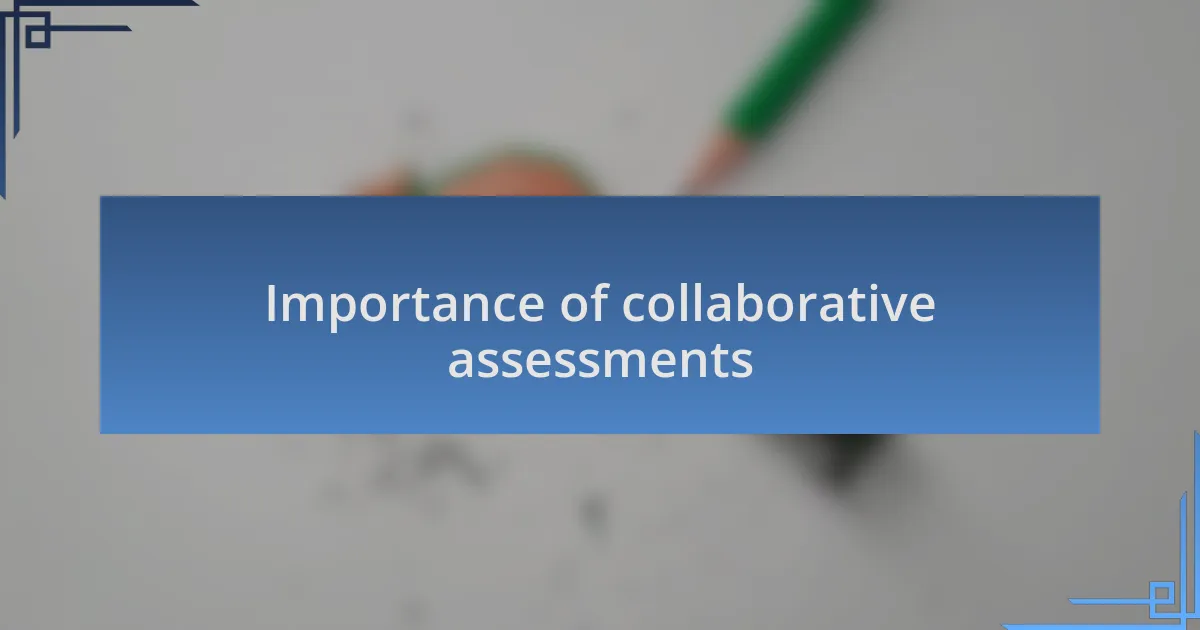
Importance of collaborative assessments
Collaborative assessments play a crucial role in understanding the unique needs of students with dyslexia. I remember a particularly enlightening meeting where educators, parents, and specialists gathered around a table to discuss a student’s challenges. The differing viewpoints opened up avenues for solutions I had never considered before, reinforcing that varied insights are essential for creating effective strategies.
The emotional impact of collaborative assessments can’t be overstated. The shared determination among team members to support a student creates an atmosphere of hope and encouragement. Isn’t it powerful when we recognize that our combined efforts can lead to breakthroughs that could change a student’s academic journey? That shared commitment creates a sense of accountability that makes everyone involved even more invested.
Moreover, these assessments help to cultivate tailored learning experiences. For instance, during one project, we collectively developed strategies that catered to a student’s specific interests, making learning more engaging and effective. When we collaborate, we don’t just assess; we actively shape an environment where every child feels valued and understood. Don’t you think that such personalized approaches can make all the difference in how students with dyslexia perceive their own potential?
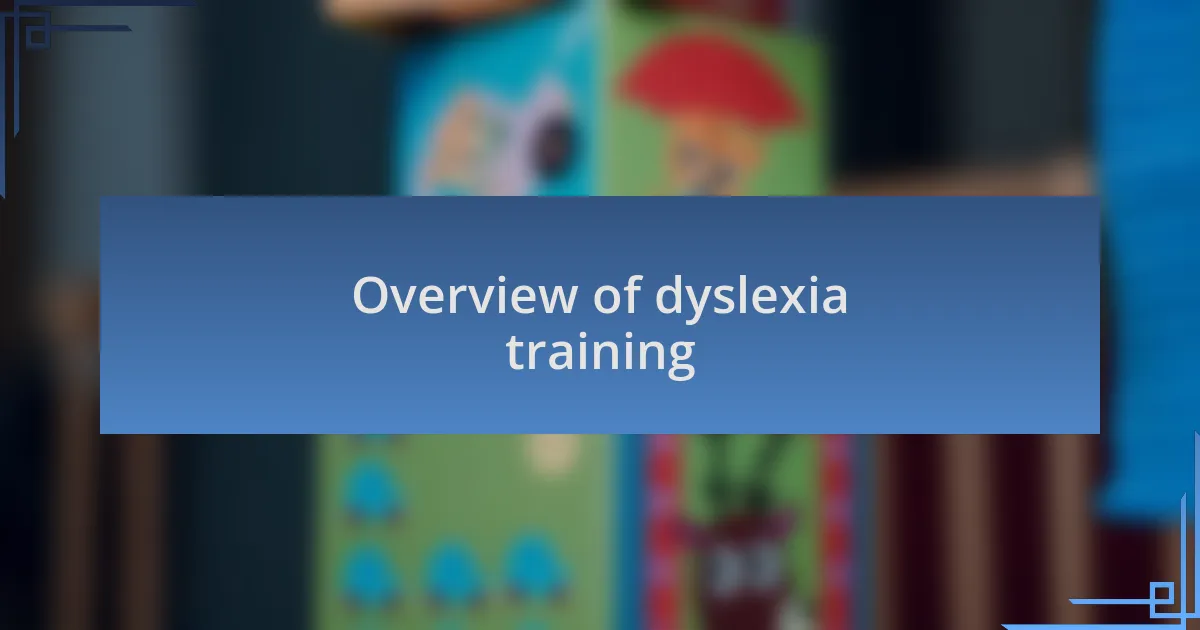
Overview of dyslexia training
Understanding dyslexia training encompasses a multifaceted approach that addresses the unique challenges faced by learners with this condition. From my experience, effective training integrates specialized strategies that not only improve reading skills but also foster confidence in students. I recall a workshop where we explored techniques like phonemic awareness and multisensory instruction; the excitement among attendees was palpable as we recognized how these methods could truly empower our students.
Additionally, dyslexia training often emphasizes the importance of a supportive environment. I remember working with a group of educators who shared their personal stories of struggling with dyslexia as children. Their vulnerability prompted deep discussions on creating inclusive classrooms that celebrate diversity in learning. Isn’t it fascinating how personal experiences can shape our teaching philosophies and ultimately impact our students’ success?
Moreover, successful dyslexia training requires ongoing support and collaboration among educators, parents, and specialists. Reflecting on a long-term coaching program I was part of, I noticed how vital it was for all parties to remain connected and engaged. Did you know that consistent follow-up meetings can significantly enhance a student’s progress? It’s true—building a community around support not only reinforces our commitment, but it also enriches the entire learning experience.
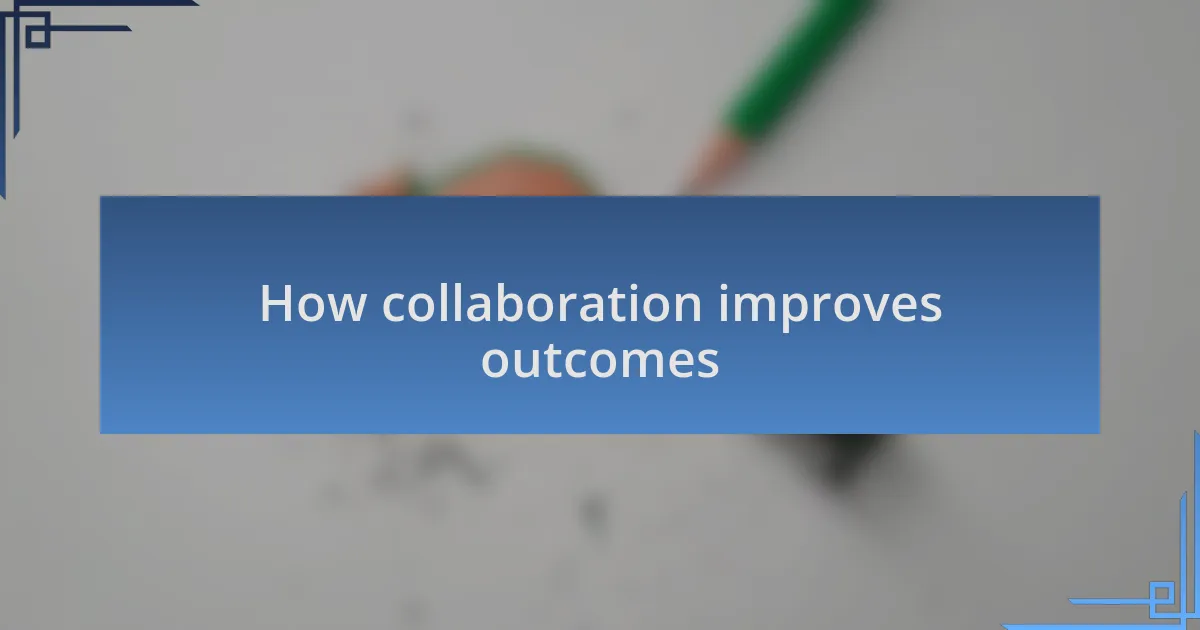
How collaboration improves outcomes
Collaboration can significantly boost the effectiveness of assessments in dyslexia training. I once participated in a project where educators and speech therapists worked side by side to design assessments tailored to individual needs. The result was a remarkable improvement in students’ performance; they felt more understood and supported, which led to greater engagement and motivation. Have you ever noticed how students thrive when they know their voices are heard?
When educators share insights and feedback with parents, the outcomes become even more powerful. I remember a time when a parent shared an observation about her child’s strengths at home that we had overlooked in our assessments. This collaboration allowed us to adjust our approach, leading to notable progress. It’s amazing how small adjustments, driven by shared perspectives, can create a ripple effect in learning outcomes.
Furthermore, involving students in the assessment process encourages ownership of their learning. I once guided a group of students in self-assessment exercises, where they reflected on their own challenges and successes. This experience not only fostered a sense of responsibility but also deepened their commitment to improvement. Isn’t it empowering for students to feel they contribute to their own learning journey?
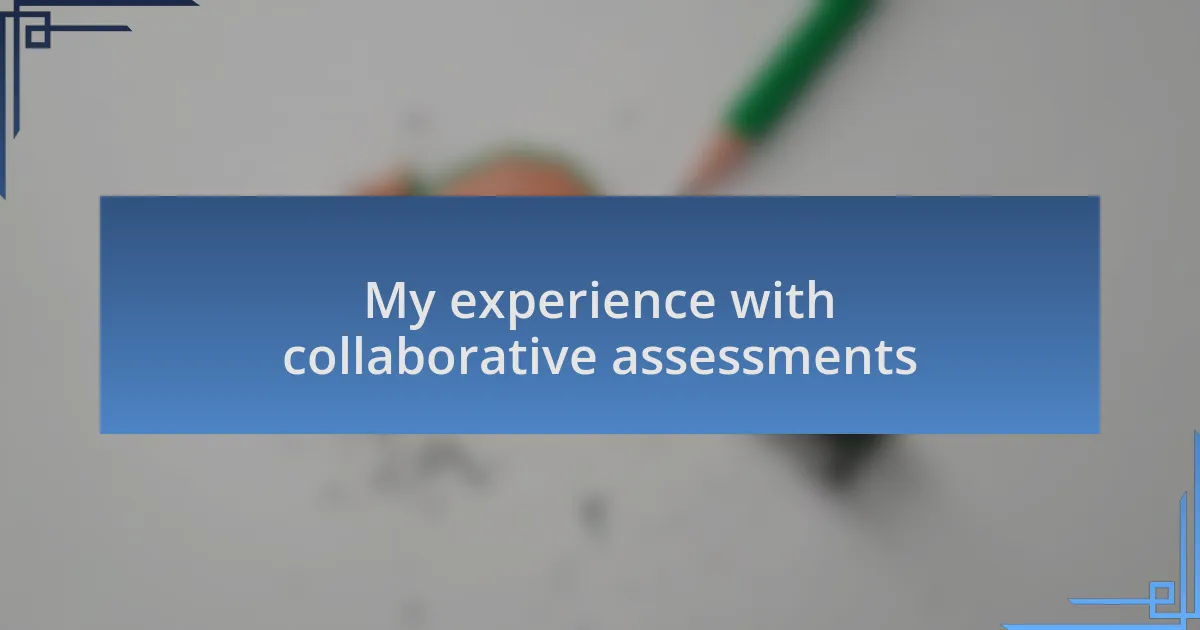
My experience with collaborative assessments
My experience with collaborative assessments has been transformative, both for my professional growth and the students I work with. I remember teaming up with a colleague from the special education department; we spent hours discussing our students’ unique challenges. As we shared notes and strategies, it struck me how important it is to combine our different perspectives. Isn’t it fascinating how collaboration can spark new ideas that neither of us would have thought of alone?
One memorable instance involved a student who struggled with reading comprehension. During our collaborative assessment sessions, we invited the student to express their thoughts openly. Listening to their insights not only changed our approach but also illuminated strategies that were previously overlooked. It’s heartwarming to witness such breakthroughs—don’t you think that when students are encouraged to share, they often reveal critical information that can guide our assessments?
Additionally, I found that peer collaboration among educators creates a supportive community. Not long ago, I was part of a workshop where we shared our assessment tools and learned from each other’s experiences. This exchange fostered a sense of camaraderie and reinforced the idea that we are all in this together. It makes me wonder: how much further could we go if we all embraced this collaborative spirit in our assessments?
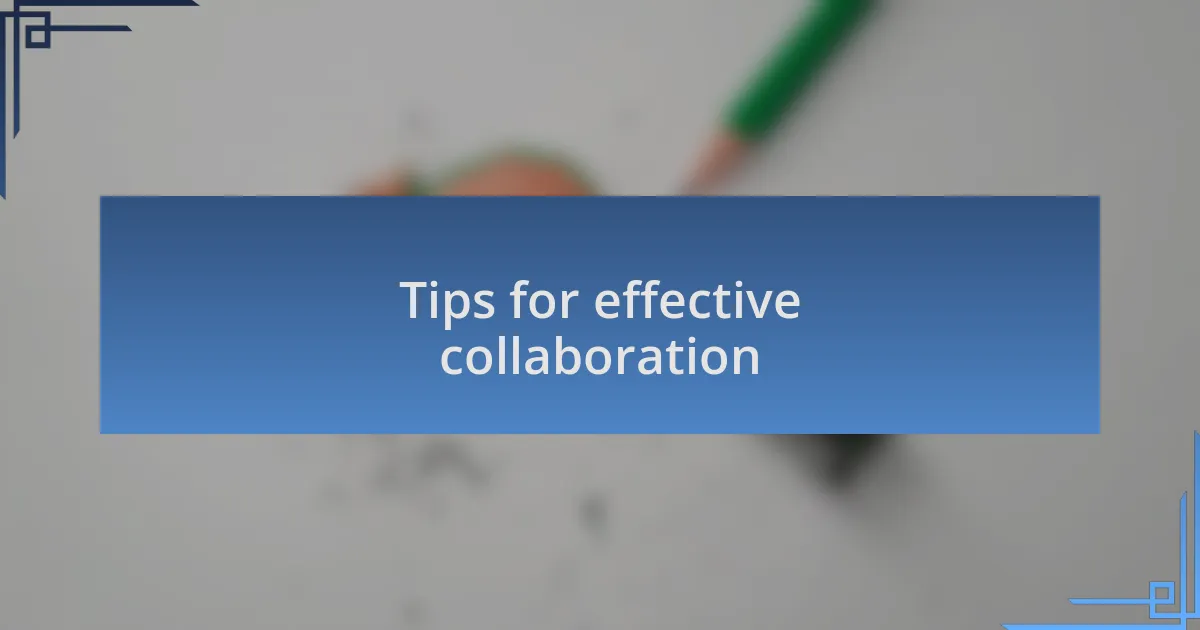
Tips for effective collaboration
Engaging in effective collaboration requires open communication. I remember a time when a colleague and I set aside our preconceived notions and held a candid conversation about how we perceived our students’ needs. This direct dialogue not only helped us align our goals but also cultivated trust, allowing us to tackle challenging assessments together.
Another vital tip is to establish clear roles within the team. During a recent group project, we designated specific responsibilities based on each member’s strengths. I found that when everyone knew their role, the dynamics shifted positively; it created a more efficient workflow and let us capitalize on our individual expertise. Isn’t it remarkable how simple clarity can transform a group’s output?
Flexibility in approach is equally crucial. I recall a situation where our initial plan didn’t resonate with our students. Instead of sticking rigidly to our original strategy, we adapted on the fly, encouraged by the students’ feedback. This willingness to pivot not only improved our collaboration but forged a deeper connection with the students. How often do we miss valuable opportunities when we cling too tightly to our original ideas?
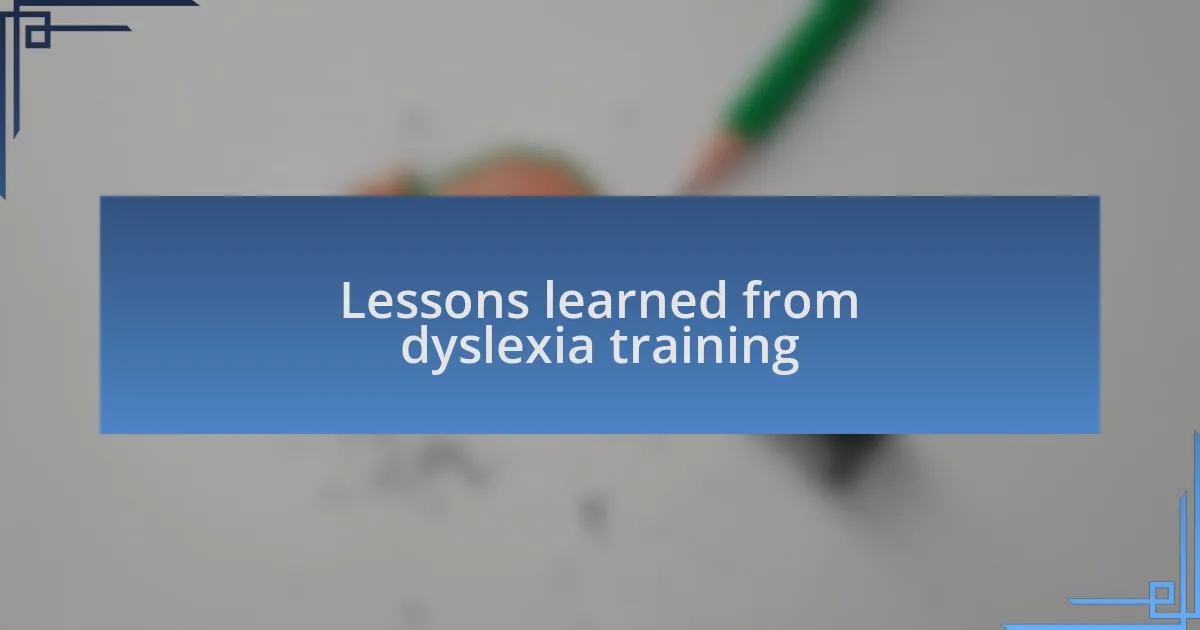
Lessons learned from dyslexia training
One significant lesson I’ve learned from dyslexia training is the importance of understanding diverse learning styles. I vividly remember a workshop where we explored different strategies tailored for dyslexic students. As we tried out various techniques, I realized how essential it is to recognize that what works for one student might not work for another. Have you ever found yourself using a method that just didn’t seem to resonate?
Another poignant takeaway from my experience in dyslexia training has been developing patience and empathy. I can recall a situation where a student struggled for weeks, and I felt frustrated until I took a step back and acknowledged their challenges. Watching them finally overcome that hurdle filled me with a profound sense of pride and reinforced my belief in the power of support. Isn’t it incredible how a little compassion can make such a difference?
Lastly, collaborative assessments have taught me how powerful peer feedback can be. In one of our sessions, we conducted small group assessments, and the insights we shared with each other shaped our understanding of the dyslexia experience. I found it striking how, through collaboration, we all gained perspectives that enriched our approaches to teaching. Have you ever considered how much more effective we can be when we share our collective wisdom?